Abstract
Securing a ship’s safe stability is essential. Thus, monitoring the stability parameters of the IMO requirements is required to provide an alert about the risk of the safety of ships’ stability to the captain, officers, and the crew of a ship. However, calculating all ships’ intact stability parameters is complex without ship loading software or equipment. To evaluate ships’ intact stability parameters, a convenient methodology to simply calculate them is necessary as a supplementary method for ships in the absence of loading software or equipment. In the present study, the Simple Evaluation Methodology for Intact Stability (SEMIS) is proposed. SEMIS is introduced for simply evaluating the safety of ships’ stability according to GM. Based on the stability parameters of 336 loading conditions of 19 model ships, empirical formulas of SEMIS are derived. To verify the proposed methodology, the stability parameters of two model ships in 28 loading conditions are calculated using the proposed empirical formulas and the principal calculation methods, respectively, and then compared. The developed SEMIS efficiently evaluates the ships’ stability using only GM.
1. Introduction
For the safe navigation of ships, maintaining sufficient stability according to Internation Maritime Organization (IMO) stability regulations is essential. Due to the lack of sufficient stability, many ship capsizing accidents have been reported, such as the Golden Ray car carrier accident on 8 September 2019 in Georgia, the United States, and the Dolgorae fishing vessel on 5 September 2015 in the Chuja Islands, as shown in Figure 1 [1,2].
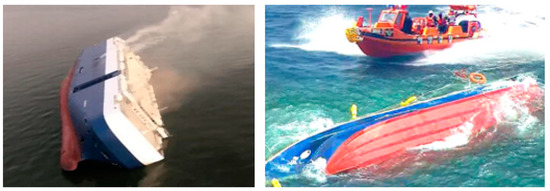
Figure 1.
Golden Ray car carrier (left) and Dolgorae fishing vessel (right) accidents.
The stability regulations improve the safety of the ships by providing ships’ operators with the guidelines. IMO [3] established the stability regulations in 1985, and they were amended in Resolution A.749 (18) in 1993 [4] and Resolution MSC.267 (85) in 2008 [5].
Several studies had been conducted in the 1930s before IMO established the stability regulations. The basic concept of the weather criterion was introduced [6]. Rahola [7] provided the procedure for the assessment of the adequate stability of a vessel. These two studies became the foundation for further studies regarding ships’ stability safety. IMO has developed intact stability criteria for various types of ships, culminating in the completion of the code on intact stability. The international standard code includes fundamental principles against capsizing, the weather criterion, the effect of free surfaces, icing, and watertight integrity. Generally, these criteria are regarded as the first generation of the intact stability criteria [8,9]. Based on the guidelines of the intact stability criteria of IMO, many studies have been carried out. The intact stability of fishing vessels operating in the Atlantic and Pacific Oceans under the action of fishing gear pull, beam waves, and wind were studied [10]. Hu et al. [11] suggested a stability criterion of sail-assisted ships based on the stability requirements for seagoing ships. Deybach [12] discussed the limitations of the IMO intact stability regulations when applying them to naval ships. Marutheri Parambath [13] suggested intact stability criteria for the weather criterion applied to rivers.
There have been many studies on intact stability assessment to provide convenient functionality from the perspective of the ships’ operators. Their main purpose is to develop functions that are more convenient and easier for the captain, officers, and crew of a ship to evaluate the condition of the ship’s intact stability. Brown and Witz [14] validated a method for evaluating the stability of a ship using roll period in real time. Terada et al. [15] developed a system to evaluate the GM of a ship using the roll natural frequency of container ships. A system was developed by [16] to estimate the GM of a ship and evaluate its stability using lateral fluctuations in mid-sized fishing vessels. Santiago et al. [17] evaluated the stability of a fishing vessel in operation in real time. A real-time evaluation system for second-generation intact stability using a radar and buoy was proposed by [18]. These studies provided useful tools to practically evaluate a ship’s intact stability performance in real time while operating on the sea. The Wolfson Unit [19] proposed an estimation function based on the experimental data for the wave height causing vessels to capsize and it was composed of variables related to the GZ curve. The estimation equation was proposed for a significant wave height using the ship length to induce the ship’s rollover when the ship stability meets the IMO minimum requirement, drawing on a case in which a ship capsized [20]. Based on the research of [19,20], the guidelines for stability assessment for ship owners and crew were developed by [21]. A single criterion value was proposed for conveniently evaluating the stability performance of fishing vessels to show the satisfaction of the IMO stability regulation [22]. For simply evaluating the IMO intact stability, except weather criteria, an evaluation method was proposed by [23]. Based on these studies, the development of a system that acquires ships’ motion data using a real sensor to evaluate the ship’s intact stability performance in real time is underway. From the point of view of ship operators, who have relatively less knowledge for evaluating the risk of ships’ stability performance, these studies are considered effective.
However, evaluating ships’ stability performance only using GM is not sufficient. Ships have to satisfy eight intact stability parameters including GM. Thus, a convenient methodology to simply calculate all of a ship’s intact stability parameters is necessary for the captain, officers, and crew to be able to evaluate the ship’s stability performance. In this study, the Simple Evaluation Methodology for Intact Stability (SEMIS) is proposed for efficiently determining whether a ship complies with the IMO intact stability regulations. As a method for determining the safety of the ship’s stability, the empirical formulas of SEMIS were derived based on the IMO intact stability parameters of 336 loading conditions of 19 model ships. After calculating GM, the other seven IMO intact stability parameters were calculated using simple empirical formulas according to the variable of GM. Then, each parameter was evaluated for its compliance with IMO intact stability regulations. To verify the proposed SEMIS, the stability parameters of two model ships in 28 loading conditions were calculated using the proposed empirical formulas and principal calculation methods, respectively, and then compared. These results were evaluated according to IMO intact stability regulations. The proposed SEMIS successfully pointed to loading conditions with insufficient stability.
2. Model Ships and Loading Conditions
A variety of ship types were employed to develop a widely applicable evaluation methodology, named SEMIS. The basic ships’ particulars of the 19 ships are presented in Table 1. There were seven different types of ships, namely four bulk carrier ships, four container ships, two tanker ships, three passenger ships, four training ships, one research ship, and one general cargo ship. The loading conditions comprised 336 scenarios of 19 model ships’ stability booklet data, as shown in Table 2.

Table 1.
Particulars of model ships.

Table 2.
Loading conditions.
3. Parameters of IMO Intact Stability Regulations
Eight IMO intact stability parameters, including the GM of IMO stability requirements, were considered to develop SEMIS. Table 3 shows the IMO intact stability parameters and their criteria. Eight stability parameters, including GM, are general criteria for cargo ships.

Table 3.
IMO intact stability parameters and criteria.
The eight stability parameters are summarized as follows:
- GM (Metacentric Height): The height from the center of gravity to the transverse metacenter, taking into account the influence of the free surface of the liquid.
- : The righting arm at 30° of the heeling angle.
- : The angle at which the GZ reaches the largest value in the range.
- : The area of “a” under GZ curve between 0° and 30° of the heeling angle.
- : The area of “b” between 30° and 40° (or flooding angle, whichever is less).
- : The area of “a + b” between 0° and 40° (or flooding angle, whichever is less).
Figure 2 (left) shows three patterns of the area under the GZ curve in the IMO stability regulation. Figure 2 (right) shows the weather criterion. The steady wind pressure on the ship leads to a heeling arm (). As a result, a heel angle () is generated to achieve equilibrium, and the wave motion causes the ship to heel with an angle () against the wind. At this moment, it should not exceed the value of 16° or 80% of the immersion angle, whichever is less. Moreover, due to the gust wind pressure, the ship is subjected to inclination. In this case, the area of “d” should be larger than the area of “c”.

Figure 2.
Area under GZ curve (left) and weather criterion (right) [24].
4. SEMIS
The SEMIS can simply evaluate the seven IMO intact stability parameters () according to GM, which is calculated before the ship’s departure from a port. The seven IMO intact stability parameters are calculated using simple empirical formulas using GM. Then, each parameter is evaluated for its compliance with IMO intact stability regulations. Finally, the safety of ships’ stability is assessed according to evaluated parameters.
4.1. Derivation of Empirical Formulas of SEMIS
Based on the seven IMO intact stability parameters described above and two additional parameters, namely and , of 336 loading conditions of 19 model ships, this study derived the empirical formulas that allow a captain, officers, and crew to simply calculate the stability parameters only using GM. Figure 3 presents the trend lines of the seven IMO intact stability parameters and areas of “c” and “d” of the weather criterion according to GM.
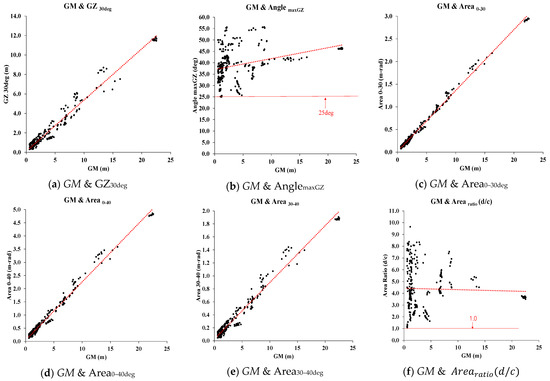

Figure 3.
Trend lines of the seven IMO intact stability parameters according to GM.
For the fitting procedure of the IMO intact stability parameters according to GM, the linear function using the method of least squares was introduced for eight parameters except for the heeling angle . The reciprocal function using the method of least squares was introduced for the heeling angle to improve the coefficient of determination as shown in Figure 3i. As shown in Figure 3b,f, it is problematic for and to derive proper formulas due to the low correlation. In terms of the IMO intact stability regulations for the two parameters, all their values comply with the IMO intact stability requirements as they are over 25 deg and 1.0, respectively, as shown in Figure 3b,f.
4.2. Analysis Empirical Formulas
In this section, the empirical formulas derived in Section 4.1 are analyzed for using them as discriminants for compliance with IMO intact stability regulations.
The four empirical formulas for , , , and have a high coefficient of the determination with values of 0.9611, 0.9942, 0.9870, and 0.9676, respectively, as shown in Table 4. In other words, these empirical formulas reliably reflect the relationship between the four parameters and GM.

Table 4.
Empirical formulas according to GM.
In terms of the empirical formula of the heeling angle , most of the parameters of the heeling angle are condensed in the limited range of GM of 0~2, and the slope of the trend line sharply declines, as shown in Figure 3i. It reduces the coefficient of determination of the heeling angle . Although the coefficient of determination (0.5802) of the heeling angle is relatively lower than the other four parameters, the empirical formula of the heeling angle is expected to be properly used as an indicator of compliance with the IMO intact stability requirement.
However, the coefficient of determination of the empirical formulas of and are under 0.1, as shown in Table 4. Figure 3 shows the characteristics of these three IMO intact stability parameters.
Firstly, all values of of the 336 loading conditions of 19 model ships satisfy the IMO requirement of 25 deg, as shown in Figure 3b. Moreover, in the worst loading conditions of various types of ships without compliance with IMO regulations satisfy the IMO requirement of 25 deg, as shown in cases 1 to 10 in Table 5. In cases 11 to 17 in Table 5, all cases’ are over 25 deg with a low GM. In other words, it could be expected that most of the loading conditions could be evaluated as satisfying the IMO intact stability regulation of without the empirical formula of .

Table 5.
AnglemaxGZ in the low GM.
Secondly, the of the 336 loading conditions of 19 model ships satisfy the IMO intact stability regulation in all scenarios. In terms of the coefficient of determination of the empirical formulas of ,which is 0.0009, the formula is an unreliable trend line. Thus, instead of using the empirical formulas of , the empirical formulas of and , which have a high determination of 0.9676 and 0.9769, respectively, were used for calculating . The scale of the graph of is four times larger than , as shown in Figure 3g,h. The using the empirical formulas of and is 4.008.
4.3. Concept of SEMIS
The SEMIS can simply evaluate the seven IMO intact stability parameters according to GM. Finally, according to the evaluated parameters, the safety of ships’ stability is assessed. Figure 4 shows the details of the procedure of the four phases of SEMIS.
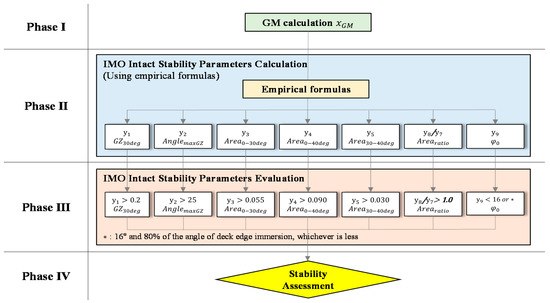
Figure 4.
Concept of SEMIS.
In Phase I, ships’ officers calculate GM using the practical method to calculate KG and KM with a hydrostatic table according to the ship’s displacement. After calculating GM, the other seven IMO intact stability parameters are calculated using simple empirical formulas according to the variable of GM in Phase II. In Phase II, five empirical formulas, namely , , , , and the heeling angle , as shown in Table 4, are used to calculate each parameter. The empirical formulas of and are used for calculating in Phase II. As mentioned in Section 4.2, is considered as satisfying the IMO intact stability regulation of without the empirical formula. In Phase III, each parameter is evaluated for its compliance with the IMO intact stability regulations. Finally, according to the evaluated parameters, the safety of the ship’s stability is assessed in Phase IV.
5. Verification of SEMIS
5.1. Model Ships for the Verification
Two types of vessels were introduced to validate SEMIS. The basic information and general layout of the two vessels are presented in Figure 5 and Table 6. The first model ship was a 5600-ton class general cargo ship operated in the East Asia sea. The deadweight of the general cargo ship was 3600 ton. The second model ship was a 9100-ton class maritime university training ship operated. The deadweight of the training ship was 3600 ton and it was able to accommodate 239 persons.
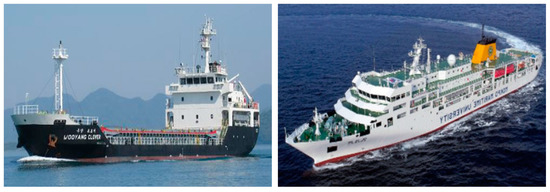
Figure 5.
Model ships of general cargo ship (left) and training ship (right).

Table 6.
Particulars of model ships.
5.2. Results and Discussion
In Table 7, we present the principal methods used to calculate seven IMO intact stability parameters () according to GM of a variety of loading conditions of the two model ships.

Table 7.
Stability calculation using the principal methods.
There were different 13 cargo loading conditions for the general cargo ship, including two loading conditions that did not satisfy the IMO intact stability requirements, as shown in Table 7. There were different 15 loading conditions for the training ship, including two loading conditions that did not satisfy the requirements, as shown in Table 7.
Table 8 shows the results of five parameters (, , , , and the heeling angle ) using empirical formulas and error ratios compared to results calculated using the principal methods.

Table 8.
Stability calculation using the empirical formulas and error ratio.
The four empirical formulas of SEMIS for , , , and , which had a high coefficient of determination of 0.9611, 0.9942, 0.9870, and 0.9676, respectively, reliably calculated each parameter with a low error ratio, as shown in Table 8. Accordingly, the four empirical formulas of SEMIS successfully evaluated unsatisfied parameters in terms of their compliance or non-compliance with IMO regulations, as shown in Table 8. Although the heeling angles using the empirical formulas of SEMIS have a relatively higher error ratio than other parameters, for the reasons mentioned in Section 4.2, we were successful in evaluating the heeling angles for their compliance with IMO regulations, for scenarios 12 and 13 of the general cargo ship and scenarios 14 and 15 of the training ship, as shown in Table 8.
Table 8 shows the results of five IMO intact stability parameters, except for and , using the empirical formulas of SEMIS. As mentioned in Section 4.2, complied with the IMO intact stability requirement as it was over 25 deg in all scenarios, as shown in Figure 4 and Table 7. Hence, most of the loading conditions could be evaluated as satisfying the IMO intact stability regulation of .
Additionally, as stated in Section 4.2, complied with the IMO intact stability requirement of 1.0 in all scenarios, as shown in Figure 3. In Table 7, the parameters of in all scenarios are at least two times higher than the IMO regulation. It is inefficient to consider and as variables for SEMIS. Thus, the two parameters could be considered as generally compliant with the IMO intact stability requirements in most loading conditions.
The parameters with an error ratio of over 30% are indicated in blue and those that are non-compliant with the IMO stability regulations are indicated in red in Table 8. Additionally, Figure 6 shows the parameters, except for the heeling angles with an error ratio between +50% and −50% compared to the results using the principal methods. As shown in Figure 6, the error ratio of the four parameters of , , , and under ± 30% is 96.6%. Moreover, the error ratio of the four parameters under ± 10% is 49.1%. The average error ratio of the four parameters is 13.9%. Although the parameter of GM of the general cargo ship in scenario 13 complies with the IMO regulation as it is over 0.15 m, the SEMIS successfully evaluates unsatisfied parameters such as Area0–30 and Area0–40 of the GZ curve and the heeling angles .
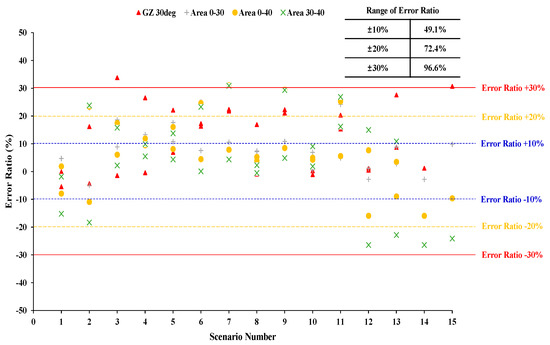
Figure 6.
Error ratio of all parameters using empirical formulas.
Table 9 presents the results of the procedure of SEMIS of the 13 scenarios of the general cargo ship and the 15 scenarios of the training ship for efficiently determining whether ships can comply with IMO intact stability regulations. As shown in Table 9, SEMIS was successful in evaluating the parameters according to GM for their compliance with IMO regulations. SEMIS perfectly evaluated the unsatisfied scenarios 12 and 13 of the general cargo ship and scenarios 14 and 15 of the training ship in Table 9. Hence, SEMIS is a convenient and easy method for the captain, officers, and crew of a ship to evaluate the condition of the ship’s intact stability.

Table 9.
Comparison of compliance with IMO intact stability regulations.
6. Conclusions
In the present study, SEMIS is proposed for simply evaluating IMO intact stability parameters according to GM. Based on the stability parameters of 336 loading conditions of 19 model ships, empirical formulas were derived. To verify the proposed SEMIS, the stability parameters of two model ships in 28 loading conditions were evaluated. The following conclusions and recommendations for further studies can be drawn.
- The SEMIS comprises four phases (Calculating GM, Calculating Parameters, Evaluating Parameters, and Stability Assessment in sequence) for evaluating IMO intact stability parameters, as shown in Figure 4. From the point of view of ship operators who are working in ships without ship loading software or equipment and have relatively less knowledge for evaluating the risk of ships’ stability performance, SEMIS is considered an effective supplementary method.
- The developed SEMIS efficiently evaluates the ships’ stability using only GM, whether compliant with the IMO regulations or not. As shown in Table 9, SEMIS perfectly evaluates four insufficient loading conditions in a total of 28 scenarios.
- In further studies, additional types of ships and loading conditions will be considered in order to improve the reliability of the empirical formulas of SEMIS. Additionally, experiments using a sensor that measures the roll period of a ship, followed by evaluations using SEMIS, will be carried out in future studies.
Author Contributions
Conceptualization, investigation, methodology, validation, supervision: N.-K.I. Conceptualization, software, data Curation, investigation, writing—original draft, writing—review and editing: D.W. Conceptualization, investigation, methodology, validation: H.C. All authors have read and agreed to the published version of the manuscript.
Funding
This research was supported by a grant (20015029) of Regional Customized Disaster-Safety R&D Program, funded by Ministry of Interior and Safety (MOIS, Korea).
Conflicts of Interest
The authors declare no conflict of interest.
Nomenclature
| IMO | International Maritime Organization |
| SEMIS | Simple Evaluation Methodology for Intact Stability |
| GM | Metacentric height |
| KG | Height of the ship’s center of gravity above the keel |
| KM | Height of metacenter above the keel |
| Symbols | |
| (GM) | GM (m) |
| () | Righting arm at 30° of the heeling angle (m) |
| Angle at which the GZ reaches the largest value in the range (deg) | |
| Area of GZ curve between 0° and 30° of the heeling angle (m-rad) | |
| Area of GZ curve between 0°and 40° (or flooding angle, whichever is less) (m-rad) | |
| Area of GZ curve between 30°and 40° (or flooding angle, whichever is less) (m-rad) | |
| () | Ratio of area d divided by area c |
| () | Area of GZ curve of the weather criterion between and (m-rad) |
| ( | Area of GZ curve of the weather criterion between and (m-rad) |
| ( | Heeling angle in steady wind pressure (deg) |
References
- Splash247 Four Crew Missing after Glovis Car Carrier Capsizes at Port of Brunswick. Available online: https://splash247.com/four-crew-missing-after-glovis-car-carrier-capsizes-off-port-of-brunswick/ (accessed on 27 March 2021).
- SBS Dolgorae Ho Fishing Vessel Was Capsized and Lost All Crews. Available online: https://news.sbs.co.kr/news/endPage.do?news_id=N1003161087 (accessed on 27 June 2021).
- IMO. Recommendation on a Severe Wind and Rolling Criterion (Weather Criterion) for the Intact Stability of Passenger and Cargo Ship of 24 Metres in Length and over Resolution A.562; IMO: London, UK, 1985. [Google Scholar]
- IMO. Code of Intact Stability for All Ships Covered by IMO Instruments Resolution A.749 (18); IMO: London, UK, 1993. [Google Scholar]
- IMO. Code of Intact Stability for All Ships Covered by IMO Instruments Resolution MSC.267 (85); IMO: London, UK, 2008. [Google Scholar]
- Pierrottet, E. Standards of stability for ships. Trans. Inst. Nav. Archit. 1935, 77, 208–222. [Google Scholar]
- Rahola, J. The Judging of the Stability of Ships and the Determination of the Minimum Amount of Stability Especially Considering the Vessels Navigating Finnish Waters; Faculty of Mechanical, Maritime and Materials Engineering: Aalto, Finland, 1939. [Google Scholar]
- Yamagata, M. Standard of stability adopted in japan. Trans. Inst. Navy. Archit. 1959, 417–443. [Google Scholar]
- Goldberg, L.L.S. Stability and buoyancy criteria for U.S. naval surface ships. Trans. Am. Soc. Nav. Arch. Mar. Eng. 1962, 418–458. [Google Scholar]
- Mantari, J.L.; Ribeiro E Silva, S.; Guedes Soares, C. Intact stability of fishing vessels under combined action of fishing gear, beam waves and wind. Ocean Eng. 2011. [Google Scholar] [CrossRef]
- Hu, Y.; Tang, J.; Xue, S.; Liu, S. Stability criterion and its calculation for Sail-Assisted ship. Int. J. Nav. Archit. Ocean Eng. 2015. [Google Scholar] [CrossRef][Green Version]
- Deybach, F. Intact Stability Criteria for Naval Ships. Master’s Thesis, Ecole Nationale Superieure des Ingenieurs des Etudes et Techniques d’Armement, Brest, France, 1997. [Google Scholar]
- Marutheri Parambath, J. Development of Intact Stability Weather Criterion Applicable to River-Sea Vessels. Master’s Thesis, University of Rostock, Rostock, Germany, 2019. [Google Scholar]
- Brown, D.; Witz, J. Estimation of vessel stability at sea using roll motion records. Trans. RINA 1996, 130–146. [Google Scholar]
- Terada, D.; Tamashima, M.; Nakao, I.; Matsuda, A. Estimation of metacentric height using onboard monitoring roll data based on time series analysis. J. Mar. Sci. Technol. 2019. [Google Scholar] [CrossRef]
- Santiago Caamaño, L.; Míguez González, M.; Díaz Casás, V. On the feasibility of a real time stability assessment for fishing vessels. Ocean Eng. 2018. [Google Scholar] [CrossRef]
- Santiago Caamaño, L.; Galeazzi, R.; Nielsen, U.D.; Míguez González, M.; Díaz Casás, V. Real-time detection of transverse stability changes in fishing vessels. Ocean Eng. 2019. [Google Scholar] [CrossRef]
- Ariffin, A.; Laurens, J.M.; Mansor, S. Real-time evaluation of second generation intact stability criteria. In Proceedings of the RINA, Royal Institution of Naval Architects—Smart Ship Technology 2016, London, UK, 26–27 January 2016. [Google Scholar]
- Wolfson Unit. Evaluation of Existing Criteria; Wolfson Unit MTIA: Southampton, UK, 2005. [Google Scholar]
- Wolfson Unit. Simplified Presentation of Fishing Vessels Stability Information for Vessels 12 m Registered Length and Over; Wolfson Unit MTIA: Southampton, UK, 2006. [Google Scholar]
- Deakin, B. Collating evidence for a universal method of stability assessment or guidance. Trans. R. Inst. Nav. Archit. Part A Int. J. Marit. Eng. 2010. [Google Scholar] [CrossRef]
- González, M.M.; Sobrino, P.C.; Álvarez, R.T.; Casás, V.D.; López, A.M.; Peña, F.L. Fishing vessel stability assessment system. Ocean Eng. 2012. [Google Scholar] [CrossRef]
- Im, N.-K.; Hwang, S.; Choe, H. Development of Stability Index for Vessel Operators Support System. J. Korean Soc. Mar. Environ. Saf. 2018. [Google Scholar] [CrossRef]
- Nam-Kyun, I.M.; Hun, H.C. A quantitative methodology for evaluating the ship stability using the index for marine ship intact stability assessment model. Int. J. Nav. Archit. Ocean Eng. 2021, 13, 246–259. [Google Scholar]
Publisher’s Note: MDPI stays neutral with regard to jurisdictional claims in published maps and institutional affiliations. |
© 2021 by the authors. Licensee MDPI, Basel, Switzerland. This article is an open access article distributed under the terms and conditions of the Creative Commons Attribution (CC BY) license (https://creativecommons.org/licenses/by/4.0/).

